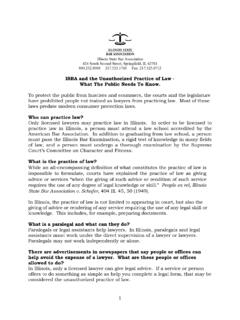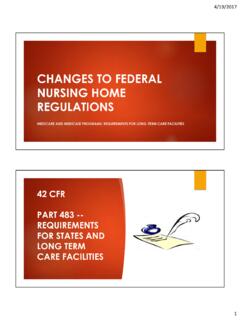Transcription of THE ILLINOIS OPEN MEETINGS ACT - Illinois State Bar ...
1 CHAPTER THREE: THE ILLINOIS OPEN MEETINGS ACT By Joe Thornton This summary of the ILLINOIS Open MEETINGS Act is designed primarily for the guidance of ILLINOIS media. It is intended to help journalists understand their rights and responsibilities under the revised act, as amended by the General Assembly in 1981 and revised periodically since then. The act is found in Chapter 5 of ILLINOIS compiled Statutes, paragraphs 120/1 through 120/6 (Chapter 102 of the ILLINOIS Revised Statutes, paragraphs 41 to 46). Inquiries regarding the act can be made to an ILLINOIS Attorney General s or county State s attorney s office. The 34-year-old ILLINOIS Open MEETINGS Act now contains a precise definition of meeting. Several issues are recurring: Did a social gathering of two or more members of a public body constitute a meeting under the act? Was it necessary for a quorum to be present for a meeting to fall under the provisions of the act?
2 Did unplanned or casual references to public issues at a social gathering or chance encounter violate the act? As amended in 1981, the Open MEETINGS Act s definitions of meeting establish two important standards: numbers and intent. The numerical standard is a majority of a quorum. The larger the public body, the greater the number of members needed to constitute a meeting. If the public body has nine members, a quorum consists of five, and three members are needed for the act to apply. If the body has only five members, the quorum consists of three, and two people would constitute a meeting under the act. The intent is to bring the provisions of the act to bear upon any group large enough to carry a vote at a subsequent meeting. The second standard is one of intent: Meeting means any gathering of a majority of a quorum of members of a public body held for the purpose of discussing public business.
3 This rules out the application of the act to any unplanned encounter or casual get-together if there was no intent to discuss public business. On the other hand, if two members of a school board visit the home of a third member with the intent of talking about school affairs, the meeting falls under the provisions of the act. But even a social gathering that was not intended as a forum for discussion of public business can suddenly become a meeting under the act if discussion turns to public business. Any deliberation on public business falls under the act even if it is only informational or preliminary - regardless of whether any attempt is made to reach consensus or decision. Three members of a school board, playing a round of golf, are in violation of the act if their conversation on the fifth tee turns to a discussion of a proposed contract, occupying the attention of all three members.
4 Public body is also defined by the act. It is an all-inclusive roster of State and local bodies, not just those receiving or expending tax revenues: Public body includes all legislative, executive, administrative or advisory bodies of the State , counties, townships, cities, villages, incorporated towns, school districts and all other municipal corporations, boards, bureaus, committees or commissions of this State , and any subsidiary bodies of any of the foregoing including but not limited to committees and subcommittees which are supported in whole or in part by tax revenue, or which expend tax revenue, except the General Assembly and committees or commissions thereof. The exclusion of the General Assembly and its committees under the Open MEETINGS Act should not be misunderstood. Public access to legislative MEETINGS is mandated by more stringent provisions of the ILLINOIS Constitution (Subsection 5 (c) of Article IV).
5 The scope of the revised act is broad, and the exceptions are narrowly and explicitly defined. The principal factor determining if a body is covered by the act is whether it is accountable to the public. The body does not have to be a duly constituted committee or subcommittee, but may be any subsidiary part of the whole. It neither has to benefit from public money, nor spend public funds. The attorney general has said: The act applies whether the public body is State or local, administrative or advisory, executive or legislative, paid or unpaid. Two broad categories remain outside the application of the act: private not-for-profit agencies that administer governmental programs, if there is no direct governmental control, and internal groups of department heads or other administrative employees who do not answer directly to a public body. Home rule units of government may adopt their own standards for guaranteeing access to MEETINGS , but such standards cannot be less stringent than those imposed by the Open MEETINGS Act.
6 Among the specific exceptions in the revised act is a meeting in which litigation is discussed. Under the old act, such litigation had to be pending. Now a public body can go behind closed doors upon a determination that litigation is probable or imminent. To prevent abuse of this provision, however, the basis for such a finding must be part of the minutes of the closed meeting. A meeting cannot be closed simply to hear general legal advice from an attorney, such as interpretations of ordinances. In sensitive and confidential matters, presumably the attorney-client privilege might be invoked, although the legislative debate established a clear intent to prevent an abuse of the privilege. Other exceptions provided in the act: collective bargaining between public employers and their employees; discussion of an appointment, employment or dismissal; testimony on a complaint against an employee or officer; consideration of an appointment to fill a vacancy on the body; MEETINGS in which the acquisition of real property is under discussion; matters of security or safety at public institutions of higher learning or public school districts; student disciplinary cases; and matters involving individual students in special education programs.
7 It is important to note that any closed meeting held under one of the specified exceptions must not stray beyond the narrow limits of the exception; an exception cannot serve as a launching platform for executive deliberations that go beyond the protected agenda item. Further, any final action at a closed meeting is prohibited. In fact, the act requires that final action be taken in an open session, preceded by a public recital of the nature of the matter being considered and other relevant information. The act provides that the public must be given notice of all MEETINGS , whether open or closed, unless a bona fide emergency requires a prompt meeting - as in the case of a sudden disaster or unexpected crisis requiring official action. All public bodies covered by the act must give public notice of their scheduled regular MEETINGS at the beginning of each calendar or fiscal year, detailing the dates, times and places of the MEETINGS .
8 All such MEETINGS must be held at times and places convenient to the public. Notice of special MEETINGS must be given at least 48 hours in advance and must include an agenda. In case of legitimate emergency MEETINGS , notice must be given as soon as practicable, and media that file annual requests are entitled to notification before the meeting, in the same manner board members were given notice. In cases of rescheduled regular MEETINGS or reconvened MEETINGS , notice must be given at least 48 hours before the meeting, along with the agenda. Public notice is made by posting a copy at the offices of the public body or at the site of the meeting. News media that file annual requests are entitled to receive copies of the notices of all MEETINGS . If the news organization has supplied an address or telephone number within the corporate boundaries of the public body, it must be given the same notice, in the same manner, as members of the body for all emergency, special, reconvened or rescheduled MEETINGS .
9 If regular meeting dates are changed, the law requires a published notice in a local newspaper at least 10 days before the first rescheduled regular meeting. Also, such a notice must be supplied to the media that have filed annual requests and must also be posted at the meeting site. A public body can go into a closed meeting only if a vote is taken in an open session, and only if the reason for going behind closed doors is stated explicitly. The reason must conform to one of the stated exceptions in the act. The closure action requires a recorded roll-call vote of the body, with a majority of a quorum approving. A series of closed MEETINGS may be authorized by a single vote, but the subsequent MEETINGS must all relate to the same topic and all of them must be held within three months of the original vote. This provision is aimed largely at facilitating a series of ongoing MEETINGS devoted to collective bargaining with public employees.
10 Although the motion to close a meeting must identify the governing exception, such as probable or imminent litigation, it does not have to include any other descriptive details, such as who is likely to bring suit. Any person may record the open portion of a public meeting, with either audio or video equipment or by other means. But there are some important restrictions. The public body is permitted to impose reasonable rules and the attorney general has enunciated a principle that such rules should not interfere with overall decorum and proceeding of the meeting. However, restrictive rules cannot be imposed on an ad hoc basis. Another restriction applies to the filming or taping of a witness unwilling to have his testimony recorded. The public body is required to prohibit such recording during the testimony of the witness. Public bodies must keep minutes at all MEETINGS , open or closed.










